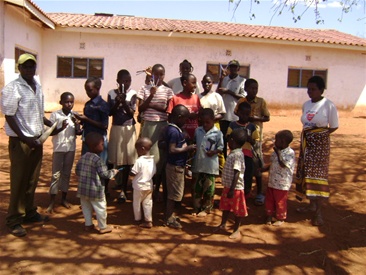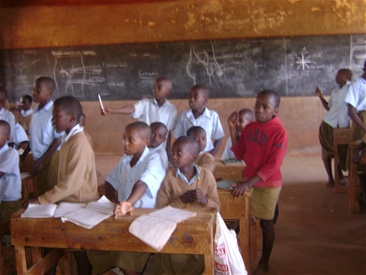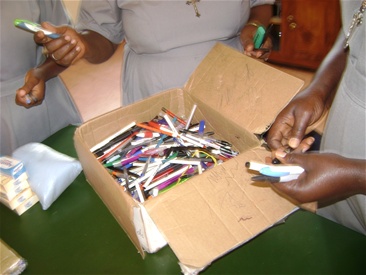 |
 |
|
 |
 |
Prepared by Project Officer Karl Kameru
Approved by Project Coordinator Sr. Genovefa Maashao
ST JOSEPH SHELTER OF HOPE "SJSHOPE" is currently running as a Non Governmental Organisation. It is deeply convinced and concerned about the value and sacredness of life and endeavours to protect, nurture and enhance it.
This initiative is committed to helping in particular, People Living With HIV and AIDS (PLWHAS) as well as those affected by the scourge, including Orphans and Vulnerable Children (OVC). Their health, well being and spiritual nourishment is a key issue.
- Over the last two decades, many Organisations; Community Based, Non Governmental, as well as individuals, have engaged themselves in the service of PLWHAS. All these have different approaches and objectives.- ST JOSEPH SHELTER OF HOPE "SJSHOPE" was started by Sr. Genovefa Maashao of the Sisters of St. Joseph of the Archdiocese of Mombasa and the Voi Community. This centre was established in 1999 as a response to the rising numbers of PLWHAS and OVC, and the numerous problems and suffering emanating from the scourge. - The Vision of the Centre is to have a community that is free from HIV and AIDS. It is committed to protect the uninfected and support the affected through treating and managing, caring, creating awareness so as to avoid further spread and re-infection, capacity building by empowering the community so as to reduce trauma, stigma and discrimination, as well as bring hope to both the infected and affected by improving the quality of their lives. The Centre is designed to address both social and cultural needs of PLWHAS together with OVC, in areas of education, nutrition and medication.
VISION
To have a community that is free from HIV and AIDS as well as other diseases by creating an environment that provides access to quality and affordable health care, nutrition, basic education and skills that provides for the support of Orphans and Vulnerable Children (OVC).
MISION
Initiate and sustain preventative measures against HIV and AIDS as well as other diseases, promote and participate in the provision of high quality affordable health care; support the infected and affected with nutrition and psychological assistance for prolonged and meaningful life.
CORE VALUES - Integrity
- Diligence
- Accountability
- Confidentiality
- Credibility
- Respect of diversity of opinions
- Respect of one’s faith
- Zero tolerance to fraudulence
- Simplicity, service and prayer SJSHOPE project goal; strengthening and empowering community for enhanced Home and Community Based Care (HCBC) to People Living With HIV and AIDS (PLWHAS) as well as Orphans and Vulnerable Children (OVC).
Broad Objective
To provide People Living With HIV and AIDS (PLWHAS) as well as Orphans and Vulnerable Children (OVC) with an environment that enhances HOPE in life (see Logo), health, and education, for the benefit of the individual, the community and the nation at large.
Specific Objectives
- Provide quality medical and nursing care to People Living With HIV and AIDS (PLWHAS) and Orphans and Vulnerable Children (OVC).
- Support Orphans and Vulnerable Children (OVC) through the enhancement of education and shelter.
- Provide Capacity building of Community Health Workers (CHW).
- Deliver Home and Community Based Care (HCBC) and Counselling to those infected and affected by HIV and AIDS.
- Initiate programs that will incorporate other diseases.
- Collaborate with other stakeholders, I.e. Non-governmental organisations, international bodies and governments of those countries with the same objectives.
- Prevent new infections
- Reduce the spread and re-infection
- Supplement in nutrition
- Uplift the economic status of PLWHAS and OVC by initiating income generating activities and educating them on management and sustainability of the same.
Project description of context
- SJSHOPE project is located in Voi division, and serves Kasogau, Mwatate and Tausa Divisions of Taita District in Coast Province of Kenya. It covers about 1485 square kilometres with a total population of 38.000 people as per the 1999 Kenya Nation Population and Housing Census. The projected population for the four divisions based on 1999 population census stands at 57486 people in Voi & Kasigau, 22,118 and 62,568 people in Tausa and Mwatate division respectively. The divisions are generally sparsely populated with only a few densely populated areas mainly due to proximity to essential services like urban centres.
- The population density stands at 26 persons per square kilometre. The population of adults aged 15 to 64 years represent 54,74 % of the total population with a female/male ratio of 1:1. 21.18% are youth aged 15 to 25 years while 21% and 10.32% respectively represents primary and secondary school children.
- The major ethnic groups living in the program area are the Sagallas, Taitas and the Durumas. Pockets of other minority groups – Wattas, Kambas and Kikuyus are also found. Taita Taveta’s economic activity includes rain-fed crop farming coupled with small livestock production. There are small scale business activities along Mombasa – Nairobi Highway and Taveta – Voi main road.
ST JOSEPH SHELTER OF HOPE has been and is still collaborating with other stakeholders in HIV/AIDS interventions. Some of the Partners are:
- Ministry of Health, Government of Kenya
- National AIDS Control Council
- World Vision Kenya
- American Foundation for Children with AIDS
- Paediatric AIDS Canada
- Marquette University
- Be The Change Inc.
- African Smile
The services offered at ST JOSEPH SHELTER OF HOPE target HIV and AIDS infected and affected people, Orphans and Vulnerable Children in Voi Municipality and its suburbs. Voi is an area with high prevalence of HIV as it lies along busy highway (Nairobi – Mombasa) that links neighbouring countries and major towns with the sea port of Mombasa for transit of goods, tourists, and long distance truck drivers.
Orphans and Vulnerable Children 
Orphans and Vulnerable Children
- Thousands of Kenyans have lost their lives since HIV was first identified in this country over two decades ago. His Excellency the then President of the Republic of Kenya declared HIV and AIDS a National Disaster on 25th November 1999, and emphasised the role of everyone in the fight against the pandemic in order to determine our own existence. Mire recently, His Excellency, President Mwai Kibaki, made a commitment in these words:
“Everyone in my government and myself now dedicate ourselves to making the defeat of HIV and AIDS our number one priority”
- ST JOSEPH SHELTER OF HOPE wishes to compliment the Government’s effort, People Living With HIV and AIDS need to be treated with dignity, be given hope and have their lives prolonged. Orphans and Vulnerable Children need better living standards, that is; good health, security, shelter, food, clothing and education. Thus, the founding of the Centre is to inject this difference.
- The Kenya Demographic Health Survey 2006 reports a national HIV prevalence of 5,9% representing a decrease from 13.6% in 1997. The HIV prevalence for Taita Taveta District currently stands at 5,8%, just below the national average. Hetero sexual contact accounts for nearly 85% of the infections which affect young productive adults between the ages of 15 and 49. About 10% of new infections are through mother to child, while a small percentage of infection is through injecting drugs use, infected blood transfusion, or occupational exposure. SJSHOPE has currently more than 500 chronically ill persons registered for Home and Community Based Care (HCBC). This is far below the need and there are still more people who need HCBC in the community.
- It is against this background that the service of HCBC was identified as a significant contributor in HIV & AIDS interventions.
- This dream can only be realised through good and regular funding. The current team co-ordinated by Sr. Genovefa, assisted by 11 members of staff doing social work, Counselling, Clinical and nursing services, Accounting, Laboratory work, and 90 Voluntary Community Health Workers is far too small to meet the current and the rapidly rising demand.
Activities undertaken by the centre
- Carry out frequent Home and Community Based Care, visits to schools, health centres and hospitals.
- Provide treatment to PLWHAS, Orphans and the community through a dispensary located within the Centre. This dispensary on an average serves 35 people a week.
- Carry out regular seminars/workshops to sensitise the community on the dangers and the spread of HIV and AIDS and how to destigmatise it.

- Carry out a feeding programme that provides highly nutritious foods and vitamin supplements to sustain the immune system of the infected and the affected people.
- Offer education to Orphans and Vulnerable Children
- Carry out counselling and VCT services to the Community.

Centre’s Challenges
Due to inadequate funds, we are unable to:
- Provide medical care and essential drugs to all infected and affected people within Voi,
- Provide sufficient good nutrition to all infected people,
- Provide OVC with basic needs including education which is a human right,
- Employ highly competent and adequate staff,
- Reach out to areas bordering Voi with high HIV prevalence rate,
- Obtain and maintain modern Medical equipment and machinery.
COMMUNITY’S CHALLENGE
- There are cases of clients failing to disclose their status to their partners thus causing poor adherence to HCBC interventions. This is associated with fear of stigma associated with HIV which remains a challenge to eradication of the scourge and as such more education is needed if stigma is to be eradicated.
- There is a high level of poverty associated with loss of income after loss of employment or death of the main household income earner. Disclosure ofHIV status to infected children remains a big challenge.
- There are different stakeholders working with CHWs using different strategies. This has brought conflict when serving the community as CHWs identify with the support Organisations rather than with the community.
- Volunteerism seems to end after some time and the CHWs who do voluntary work end up asking for incentives of which when introduced will be difficult to sustain.
- In spite of the many hardships and setbacks that we have experienced since establishment of the Centre in 1999 to date, we have directly under our care 420 PLWHAS and 400 OVC.
- We are able to carry out CD4 count and to provide treatment and care to PLWHAS and OVC through a dispensary located within the Centre. The services offered can be accessed by other people too,
- We are able to carry out feeding programmes that provide the infected and affected with highly nutritious food that sustains their immunity system.
- We have been able to offer education to 111 Orphans and Vulnerable Children.
- We are able to carry out Home and Community Based Care visits on daily basis.
- We have initiated self supporting income generating activities that are uplifting the economic status of the target group.
- We are able to carry out Paediatric ARV program.
- Baseline for OVC and PLWHA and frequent update is prerequisite for a successful Home and Community Based Care (HCBC) programme.
- Partnership with relevant government departments, local groups, institutions, Churches, Mosques, Community Welfare Groups/Organisation and individual donors is necessary for success and sustainability of Home and Community Based Care project.
- Access to appropriate nutrition and treatment for PLWHAS is still a big challenge. Many of them may not afford bus fare to the hospital for treatment and/or for routine Comprehensive Care Clinic visits and money for appropriate diet.
- Support Groups have had a significant impact not only in offering psychological support but also in encouraging openness and reducing stigma on HIV and AIDS.
- Despite knowledge of HIV and AIDS, stigma remains a challenge to eradication of the scourge and as such more education is needed if stigma is to be eradicated.
- Stakeholders Partnership and proper co-ordination of HCBC is necessary for maximum resource utilisation and for success and sustainability of HCBC.
- The Government and Communities have potential socio-cultural institutions for HCBC that have not been exploited including Department of Children Services, extended families’ network, Community welfare and sharing of resources during crisis.
Future plans for the organisation
ST JOSEPH SHELTER OF HOPE "SJSHOPE" has plans of doing the following to enhance its services to the community:
1. Home and School for the Orphan and Vulnerable Children and mentally Challenged Children.
ST JOSEPH SHELTER OF HOPE "SJSHOPE" plans to put up a home and a school for truly Orphaned Children who lack both parents and have been abandoned by the family members.
"SJSHOPE" wishes to provide these children with the basic human right of getting education,
Currently "SJSHOPE" advocates for family love and care to the Orphans and Vulnerable Children (OVC) by assisting them while living with the family members. This is with a reason of not denying the OVC the right of associating with their family members and other fortunate children. However, SJSHOPE has been facing the challenge of caring for OVC who have no one to care for them.
This forced the organisation to plan to put up a home and a school for the OVC. The school will be meant to be for the mentally challenged children. It was discovered through home visits to the sick by SJSHOPE staff that, most mentally challenged children are not offered an opportunity of going to school by their parent or caretakers. In Taita and Taveta district there are less than five schools which offer classes to the mentally unstable children and the lessons and care offered is sub standard.
SJSHOPE wishes to have a school with qualified teachers for the mentally challenged children who will be residing within the school compound under the leadership of Sisters of ST JOSEPH. The organisation has already secured a piece of land for this project and is looking for willing donors to assist in developing the land.
2. Extending the SJSHOPE health facility
ST JOSEPH SHELTER OF HOPE plans to extend its Health Facility to enable In-patient admission. This will involve putting up patients’ wards and a laundry room. Currently the facility operates as a Health Centre. The plan for Facility extension is as a result of the rising demand of in-patient admission from the community and mostly People Living With HIV and AIDS served by the facility.
SJSHOPE is ready to work with willing donors with the Objective of assisting Orphans and Vulnerable Children, People Living with HIV and the Community at Large.
ST JOSEPH SHELTER OF HOPE "SJSHOPE" being a non-profit making faith based Organisation relies upon donations and grants from well wishers to run all its activities. Beneficiaries under this program are assisted with:
- Medical Assistance
- Material Assistance
- Nutritional Assistance
- Educational Assistance
- Psyco-social Assistance
You can help us by providing donations in any form to enable us provide the prime assistance as outlined above to our beneficiaries. The donations may be from Families, Friends, Religious Groups, Companies/Organisations and will be graciously appreciated. For donation in form of cash, contact us for bank details:
St. Joseph Shelter of Hope Centre
P.O.Box 286 - 80300
Voi – Kenya.
Telephone: (+254) 43-31114
Telefax: (+254) 43-30306
Email:
centrejoseph@yahoo.co.uk
|
|
 |
|
|
|